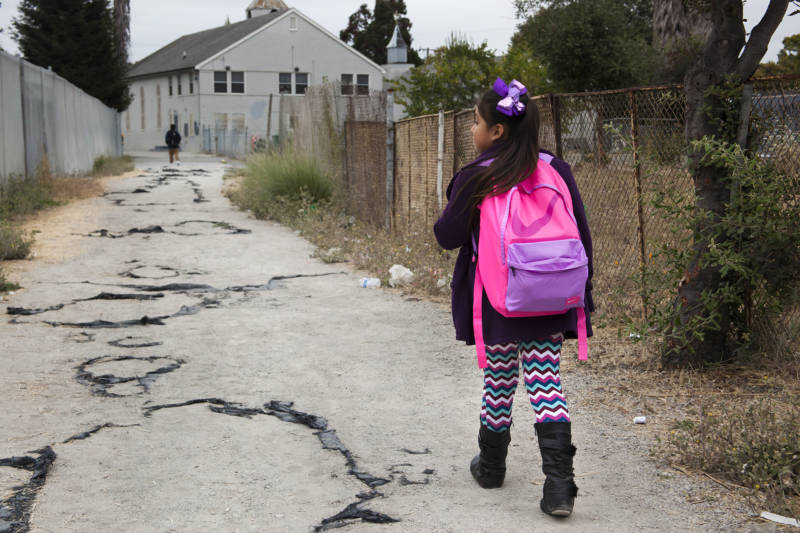Oakland Prides Itself on Being Diverse — Until It Comes Time to Send Kids to School

Celia Fragoso, 7, walks through the Oakland neighborhood of Sobrante Park on her way to Madison Park Academy on Aug. 26, 2016.(Brittany Hosea-Small/KQED)
Walking her daughter to school in their neighborhood of Sobrante Park in East Oakland, Marina Muñoz passes an old mattress on the curb and several abandoned cars. Then she crosses an empty lot covered with old clothes and smelly trash.
“Here in East Oakland, we are all poor,” says Muñoz in Spanish. “Poor in everything, including education.”
Oakland prides itself on diversity. Students in the district’s public and charter schools are 44 percent Latino, 26 percent African-American, 13 percent Asian and 9.7 percent white. But only a handful of its public schools fully reflect the district’s diversity. They are more likely to look like their own neighborhoods, which are largely segregated by race and class. That’s due in large part to the district’s enrollment policy.
Muñoz’s kids’ school, Madison Park Academy, reflects the neighborhood. It’s 95 percent Latino and African-American, and almost all the kids qualify for free and reduced lunch. More than half the kids in elementary school are English learners. Latino kids make up the biggest ethnic group in Oakland’s public schools. They’re also the most isolated from other races and the most concentrated in high-poverty schools, here and across the state.
The principal at Madison Park Academy has made a lot of improvements in recent years, with a health clinic and wraparound services for kids and families. Still, the school has larger-than-average class sizes and low test scores, compared with the top-tier schools in the district.
That bothers Muñoz. She’s convinced her kids are not receiving the same quality education as kids in the wealthy Oakland hills. One of the most frustrating moments for her was last year, when her son was a junior in high school. She said he had a substitute teacher in one of his classes for months.
“He would say, ‘They’re not even teaching me anything. Mom, come get me, I’m not doing anything,’ ” Muñoz said. “How are we going to send our kids to college if we don’t have well-trained teachers?”Oakland Prides Itself on Being Diverse — Until It Comes Time to Send Kids to School | News Fix | KQED News:
Read part 1 of this series.

